Welcome to a beloved classic that transcends generations: Old-Fashioned Coconut Custard Pie. This dessert isn’t just a recipe; it’s a warm hug, a sweet memory, and a delightful staple for any family gathering. With its rich, creamy egg custard filling generously studded with toasted coconut, it strikes a perfect balance – indulgent enough to feel special, yet comforting without being overly decadent. It’s the ultimate centerpiece for holiday tables, a crowd-pleaser that promises to satisfy every sweet tooth.
Growing up, Thanksgiving was a grand affair in my family, a feast for both the eyes and the palate. Our holiday table always sagged under the weight of delicious dishes, and dessert was no exception. It wasn’t uncommon to find at least four different types of pie, each meticulously chosen to cater to everyone’s distinct preferences. The rule was simple: no one left without enjoying their absolute favorite slice. Among these cherished choices, Coconut Custard Pie held a special, almost sacred, place.
In all honesty, the magic of that particular pie wasn’t something we created in our own kitchen. Our annual tradition involved ordering it from a charming local cider mill, renowned for baking the freshest, most delectable pies for pickup the night before Thanksgiving. The aroma of apples and spices would fill the air as eager customers lined up out the door, a testament to the mill’s legendary reputation. Every pie they crafted was simply extraordinary, and their coconut custard pie, in particular, remains my gold standard to this day.
The closing of that beloved cider mill left a void, but it also sparked a culinary quest. For years, I’ve been refining and tweaking various recipes, driven by the desire to recreate that nostalgic flavor and texture. This recipe is the culmination of that journey – a tribute to those cherished memories and the definitive Coconut Custard Pie I now proudly serve. It features a perfectly flaky, buttery crust embracing a lightly sweetened custard filling, brimming with toasted coconut flakes. Each forkful is a perfect symphony of textures and flavors, an ideal conclusion to a lavish holiday dinner or a delightful treat on any ordinary evening. Believe me, I’d never pass up a slice!
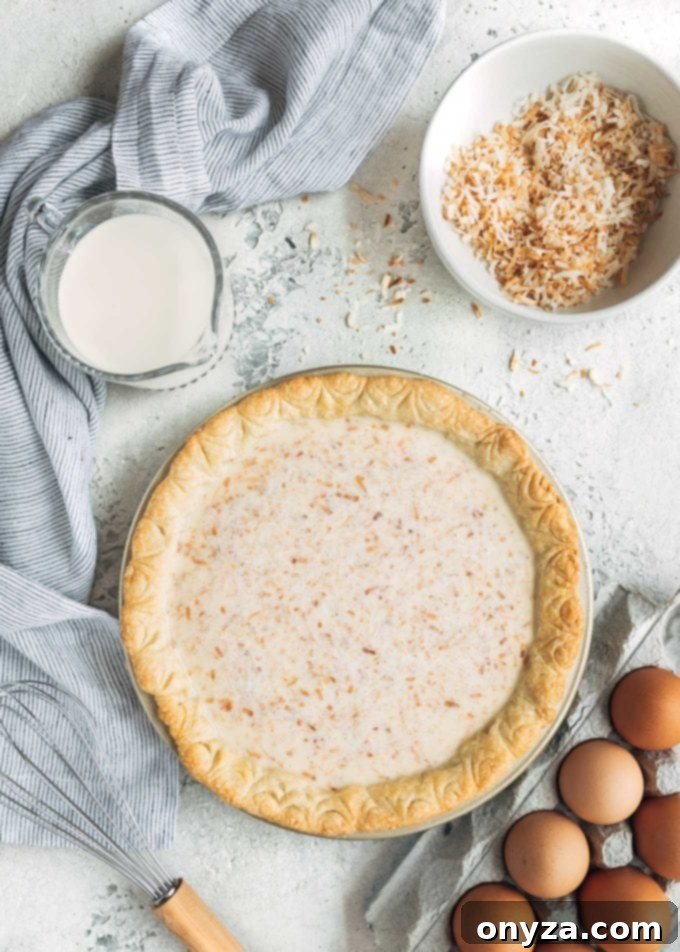
Coconut Cream Pie vs. Coconut Custard Pie: Understanding the Delicious Distinction
While their names might sound similar, Coconut Custard Pie and Coconut Cream Pie are, in fact, two distinctly different desserts, each with its own unique charm and texture. Both are incredibly delicious, but understanding their fundamental differences is key to appreciating what makes each one special. The primary distinction lies in how their fillings are prepared and set.
Coconut Custard Pie relies on a baked filling. Its luscious interior is made from a rich blend of eggs, milk, and/or cream that thickens and sets in the oven. The eggs act as a natural emulsifier and thickener, creating a firm yet tender custard that jiggles slightly when tapped. This baking process gives the custard a characteristic golden-brown top and a more compact, sliceable texture that holds its shape beautifully. It’s often served plain or with a dollop of whipped cream.
In contrast, Coconut Cream Pie features a stovetop-cooked custard filling. This custard is typically thickened with cornstarch or flour, combined with milk or cream, and then cooked on the stove until it reaches a rich, pudding-like consistency. Once cooked, it’s chilled until fully set, resulting in a silky-smooth, incredibly creamy, and often lighter texture. Coconut Cream Pie is almost always topped with a generous layer of whipped cream, sometimes piled high, and can sometimes feel like eating a bowl of decadent coconut pudding with a crust. If you can imagine eating the filling with a spoon directly from a bowl, that’s usually a cream pie. Custard pie, with its firmer set, is truly designed for slicing.
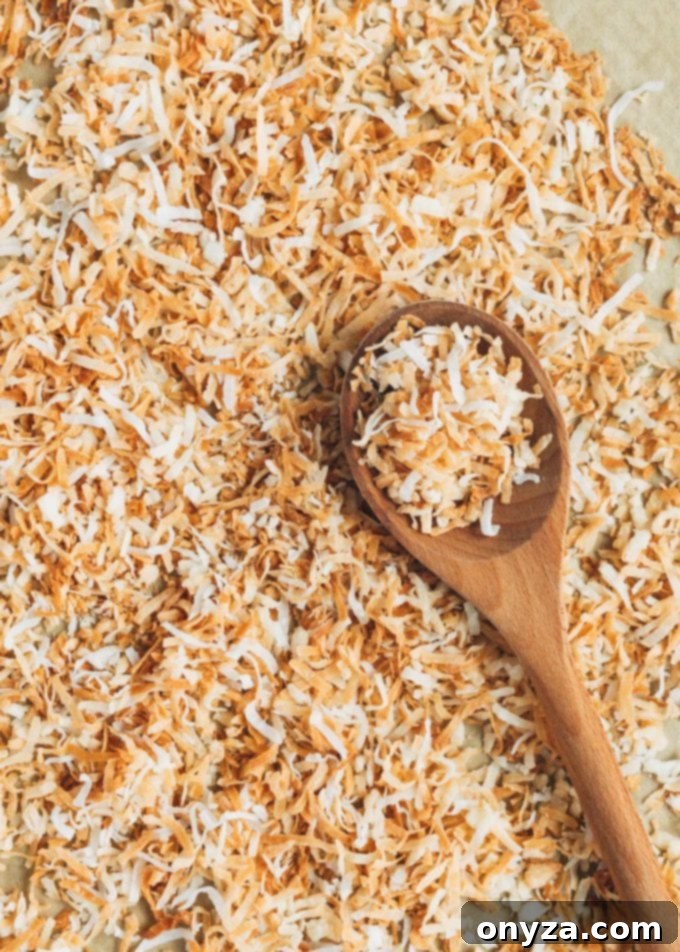
Crafting the Perfect Homemade Coconut Custard Pie: Tips and Tricks
Don’t be intimidated by the idea of making pie from scratch! Coconut Custard Pie is surprisingly one of the most straightforward pies to prepare at home. The filling comes together effortlessly – just a quick whisking of ingredients, a pour into a prepared pie shell, and then into the oven it goes. While the process is simple, a few expert tips can elevate your homemade pie from good to truly exceptional. Here are my tried-and-true techniques for achieving the best possible Coconut Custard Pie:
Say Goodbye to Soggy Crust: The Art of Blind Baking
One of the most common pitfalls when making custard pies is a soggy bottom crust. Since the coconut custard filling starts as a liquid, pouring it directly into raw pie dough and baking it allows moisture to permeate the crust before it has a chance to crisp up. The result is an undesirable soft or gummy texture.
The solution is simple yet crucial: **blind baking** (or par-baking) the pie crust before adding the filling. This technique involves partially baking the empty pie shell, giving it a head start to develop a golden, flaky texture. To blind bake, line your pie crust with parchment paper or foil, fill it with pie weights (or dried beans/rice), and bake until the edges are set and lightly browned. Remove the weights and continue baking for a few more minutes until the bottom is lightly golden. For an extra layer of protection and crispness, I always recommend baking the filled pie on a **pre-heated baking sheet**. Placing the pie dish onto a hot sheet pan delivers an immediate boost of heat to the bottom of the crust, ensuring it bakes through evenly and develops a beautifully crisp base.
Unlock Flavor: The Importance of Toasting Coconut Flakes
Sweetened shredded or flaked coconut, while delicious, can sometimes have a somewhat muted flavor when simply mixed into a baked pie. To truly awaken and intensify its tropical essence, **toasting the coconut flakes** is a game-changer. This simple step takes only about 8 minutes in the oven and makes a world of difference.
Toasted coconut develops a deeper, nuttier, and more aromatic profile that permeates the entire custard, enhancing the pie’s overall flavor. Spread your coconut flakes evenly on a parchment-lined baking sheet and toast them in a preheated oven, stirring occasionally, until they turn a beautiful golden brown and become wonderfully fragrant. This small effort yields a significant return in flavor, transforming your pie from good to extraordinary. The toasted flakes also add a subtle textural counterpoint within the creamy custard.
Have extra shredded coconut in the bag? Don’t let it go to waste! Try my Coconut-Pecan Rice Krispie Treats for another delightful coconut-infused treat!
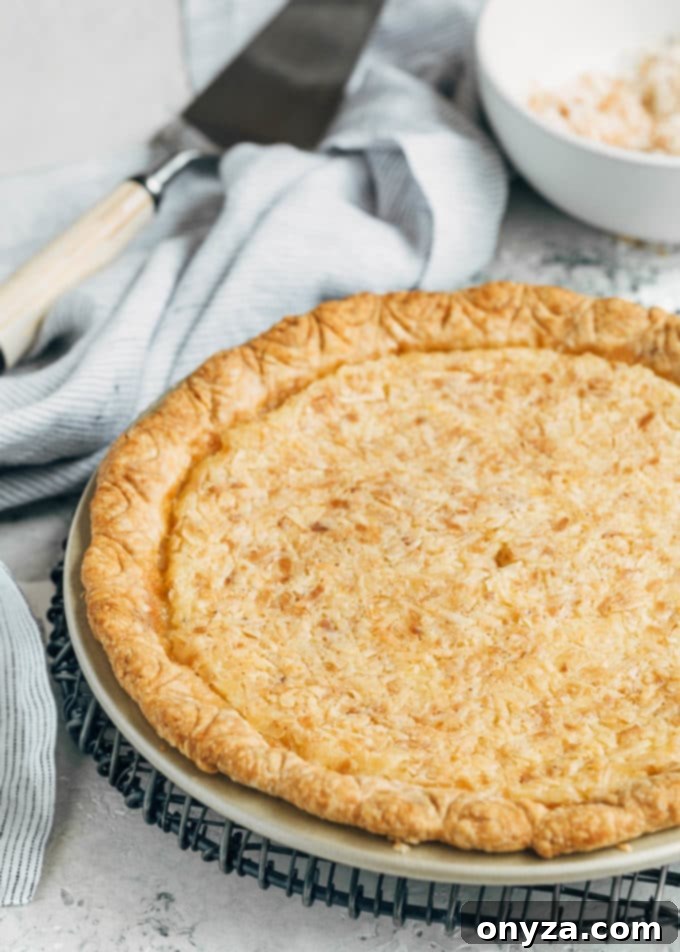
Customizing Sweetness: Find Your Perfect Balance
Traditional Coconut Custard Pie recipes often call for a significant amount of sugar – a full cup or more – resulting in a very sweet dessert. My personal preference, influenced by the less-sweet pies from the fondly remembered cider mill, leans towards a more subtle sweetness that allows the coconut and creamy custard flavors to shine through.
This recipe is designed to be adaptable to your taste. I typically opt for **1/2 cup of granulated sugar**, which, combined with the natural sweetness of the flaked coconut, creates a delicately sweetened pie that’s just right for me. If you prefer a slightly sweeter profile without venturing into overly sugary territory, **3/4 cup of sugar** is an excellent choice. For those who adore a **very sweet, classic-style pie**, feel free to use the full cup. Remember that sugar not only contributes to flavor but also impacts the custard’s texture, so slight variations are normal.
Knowing When Your Coconut Custard Pie is Perfectly Done
Determining the exact moment your custard pie is baked to perfection can sometimes feel like a culinary mystery, but there are clear indicators to guide you. The pie is ready to be removed from the oven when its top appears **puffed and beautifully golden brown**. The most reliable test, however, involves the center of the pie: gently insert the tip of a thin, sharp knife a couple of inches from the edge. If the knife comes out clean – or nearly clean – your pie is done.
I say “nearly” clean because you’ll often find a few bits of toasted coconut clinging to the knife, which is perfectly normal and indicates the filling has set. As long as the custard isn’t liquid and coating the knife, and it has cooked for the recommended **45-50 minutes**, the center should be perfectly set with a gentle wobble, rather than a sloshy liquid. Overbaking can lead to a dry, cracked custard, so trust these cues to achieve a silky-smooth texture.
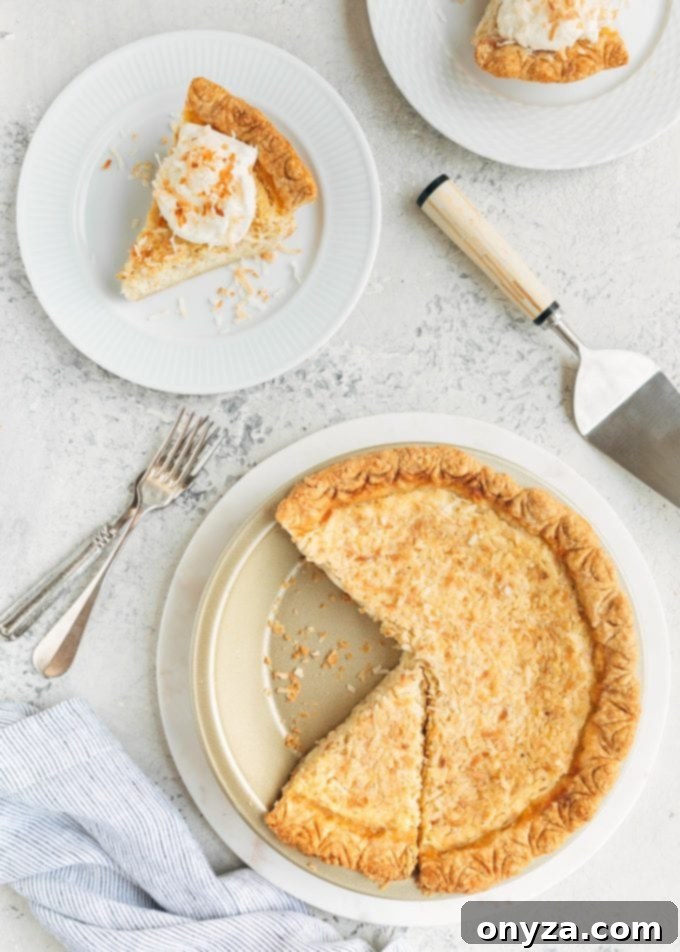
Serving and Storing Your Homemade Coconut Custard Pie
The final touches and proper storage are just as important as the baking itself when it comes to enjoying your delicious homemade Coconut Custard Pie. A well-presented and preserved pie truly elevates the experience.
Elevate Your Serving Experience
My family’s preferred way to enjoy this pie is with chilled slices, generously topped with a dollop of **lightly-sweetened whipped cream** and an extra sprinkle of crunchy toasted coconut flakes. The cool, airy cream provides a delightful contrast to the rich, creamy filling, while the additional toasted coconut adds a wonderful textural crunch and intensifies the tropical flavor in every bite. For an added touch of brightness, a tiny dusting of fresh lime zest can cut through the richness beautifully.
While we’ve always savored our pie chilled, many enthusiasts enjoy Coconut Custard Pie slightly warm, perhaps accompanied by a scoop of vanilla bean ice cream. The warm pie with melting ice cream offers a different, equally decadent experience. I haven’t personally tried this combination, but it sounds absolutely divine! If you venture into warm pie territory with ice cream, please share your thoughts – I’d love to hear about it!
Does Coconut Custard Pie Need to be Refrigerated?
Absolutely, yes. As a dairy-based dessert containing eggs and milk, Coconut Custard Pie is perishable and **must be stored in the refrigerator** after it has cooled completely to room temperature. This is essential for food safety and to maintain its freshness and quality. I recommend covering the pie snugly with plastic wrap before refrigerating. This helps to prevent the pie from absorbing any unwanted odors from the fridge and, more importantly, keeps the crust from drying out. For optimal flavor and texture, it’s best enjoyed within **two to three days**. Any longer than that, and you might find the crust begins to lose its crispness and become too soft. For longer storage, while not ideal for custard pies due to texture changes, individual slices can be carefully frozen for a couple of weeks, though a freshly made pie is always best.

Enhance your dessert experience with a perfect wine pairing! Hugh Preece, a distinguished Sommelier and Italian Wine Ambassador from Vinitaly Academy, suggests a delightful companion for this Coconut Custard Pie:
Monte TondoRecioto di Soave DOCG ‘Nettare di Bacco’, Veneto, Italy
This exquisite wine, with its “Golden yellow color, aromas of exotic fruit, citrus fruits, vanilla and almond, in the mouth it is very subtle, pervasive, very persistent and a final slightly bitter note, typical characteristic of Garganega,” offers a wonderful complement to the rich and creamy coconut notes of the pie. The wine’s natural sweetness and complex aromatic profile perfectly echo and enhance the dessert’s flavors without overwhelming them, creating a truly harmonious pairing.
Explore More Thanksgiving Pie Week Recipes:
- Caramel Apple Hand Pies
- Pumpkin Custard Pie
- Chocolate Pecan Pie with Bourbon
- Homemade Apple Pie
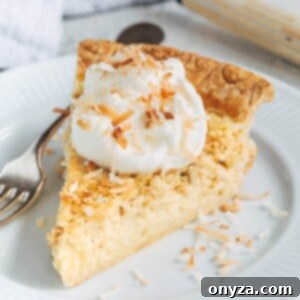
Coconut Custard Pie
Ingredients
- ½ recipe all-butter pie crust
- 1-1/2 cups sweetened, flaked coconut “angel flake” (3.9 to 4.2 ounces, depending on the brand)
- 1-1/2 cups whole milk
- 3 large eggs
- ½ to 1 cup granulated sugar *
- 1 teaspoon vanilla extract
- ½ teaspoon coconut extract (optional, if you like a fuller coconut flavor)
- ¼ teaspoon salt
- pinch ground nutmeg (optional)
- ½ cup heavy cream
- lightly-sweetened whipped cream and extra toasted coconut flakes , for garnish
Instructions
- Preheat oven to 325 degrees F. Spread coconut onto a parchment-lined baking sheet. Toast for 5-8 minutes, stirring once or twice, until the coconut is speckled with golden flakes and fragrant. Set aside.
- Raise the oven temperature to 375 degrees F. Follow the instructions in the all-butter pie dough recipe to make a blind baked, single crust pie, in a 9-inch pie plate. (I like to use a metal pie dish when making custard pies for the best textured crust.) After the crust is prepared, place the empty baking sheet back on the rack, and keep oven on at 375 degrees F.
- In a large bowl, whisk together milk, eggs, sugar, vanilla, coconut extract (if using), salt, and nutmeg (if using) until well combined. Stir in heavy cream and toasted coconut. Pour filling into the blind-baked pie crust. Place a pie crust shield over the crust edges, or cover the edges with foil.
- Bake for 45-50 minutes, until a knife inserted into the center of the pie comes out clean. Remove the pie crust shield 10 minutes before the pie is finished baking.
- Cool to room temperature and then cover and refrigerate until chilled. Slice and serve with whipped cream and a sprinkling of toasted coconut flakes.
Notes
- 1/2 cup, as written: lightly-sweetened pie
- 3/4 cup: moderate sweetness
- 1 cup: very sweet (traditional)
To properly measure angel flake coconut:
Gently spoon the coconut into a dry measuring cup, lightly patting it down when the cup is filled, only adding additional if needed. For the best results, use a kitchen scale to confirm your measurement. 1-1/2 cups should equal 3.9 to 4.2 ounces. This equates to just a little bit more than half of a 7-ounce bag, which contains roughly 2-2/3 cups of coconut.
If you pack the coconut into the measuring cup, far too much will be used, and the texture of the pie will be too dense.
Nutrition Estimate
Nutrition information is automatically calculated, so should only be used as an approximation.
Please note that our recipes have been developed using the US Customary measurement system and have not been tested for high altitude/elevation cooking and baking.
